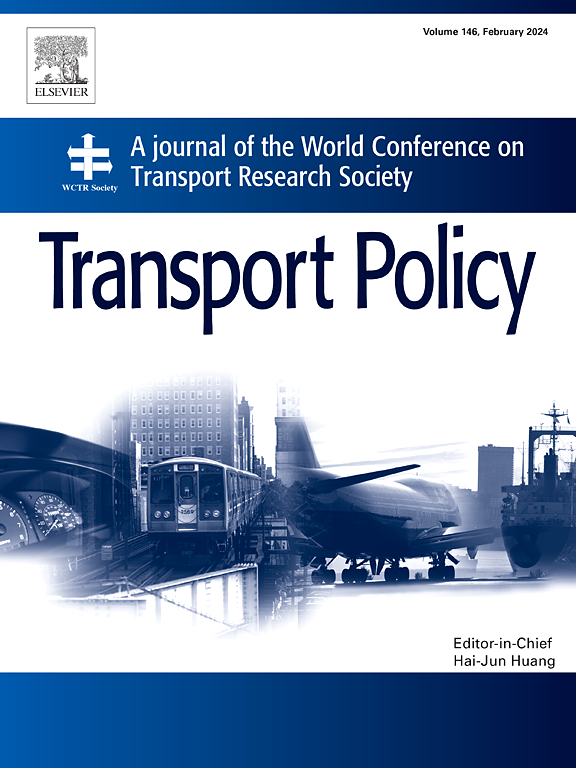Dependence or preference? Navigating public transit loyalty across heterogeneous levels of transit dependence
IF 6.3
2区 工程技术
Q1 ECONOMICS
引用次数: 0
Abstract
The remarkable decline in transit ridership in recent years, further exacerbated by the COVID-19 pandemic, has compelled transit agencies to enhance rider satisfaction to retain transit users. However, the adoption of general policies may be ineffective due to the heterogeneous nature of user perceptions that shape transit loyalty. Specifically, service quality factors might vary markedly among captive riders and those who prefer to use transit, including choice riders and voluntary riders. In this study, we investigated the transit dependence-based segmentation in the analysis of transit satisfaction and loyalty. Employing survey data from Chicago Transit Authority (CTA) riders collected in 2022, we aimed to: (1) examine the significance of heterogeneity in transit satisfaction and loyalty across captive, choice, and voluntary riders, and (2) assess the implications of overall approach versus dependence-based segmentation approach. We developed a Partial Least Squares Structural Equation Model (PLS-SEM) and conducted Permutation Multi-group Analysis (PMGA) to assess the hypothesized heterogeneity among three rider groups. Additionally, we introduced Importance-Performance Deviation Index (IPDI) to rank the service quality aspects for improvement policies specific to each group. The proposed metric highlights the variations of prioritized factors for improvement across rider groups. Our analysis reveals that while cleanliness is the most unsatisfactory aspect for all rider groups, choice riders exhibit more dissatisfaction with cleanliness. Further, reliability, particularly in terms of waiting times and service arrivals, does not meet voluntary riders’ expectations. Moreover, comfort factors are critically unsatisfactory for captive riders, especially at stations and in-vehicle, compared to other two rider groups. These findings showcase the ramifications of adopting general policies instead of group-specific strategies. The study provides transit agencies with actionable insights to develop informed and targeted retention strategies, ultimately enhancing transit users’ satisfaction and loyalty.
依赖还是偏爱?跨越不同交通依赖水平的公共交通忠诚度导航
近年来,公共交通客流量显著下降,COVID-19大流行进一步加剧了这一情况,迫使公共交通机构提高乘客满意度,以留住公共交通用户。然而,由于影响运输忠诚度的用户感知的异质性,采用一般政策可能是无效的。具体而言,服务质量因素可能在强制乘客和喜欢使用公共交通的乘客(包括选择乘客和自愿乘客)之间存在显著差异。在本研究中,我们研究了基于交通依赖的细分在交通满意度和忠诚度分析中。利用芝加哥交通管理局(CTA)在2022年收集的乘客调查数据,我们的目的是:(1)检验强制性、选择性和自愿性乘客在交通满意度和忠诚度方面的异质性的重要性;(2)评估整体方法与基于依赖的细分方法的影响。我们建立了偏最小二乘结构方程模型(PLS-SEM),并进行了置换多组分析(PMGA)来评估三组骑手之间的假设异质性。此外,我们引入了重要性-性能偏差指数(IPDI),对每个组特定的改进策略的服务质量方面进行排名。所提出的指标强调了不同骑手群体的优先改进因素的变化。我们的分析显示,虽然清洁是所有骑手群体最不满意的方面,但选择骑手对清洁表现出更多的不满。此外,可靠性,特别是在等待时间和服务到达方面,没有达到自愿乘客的期望。此外,与其他两种乘客群体相比,“俘虏”乘客的舒适度非常不令人满意,尤其是在车站和车内。这些发现显示了采用一般政策而不是特定群体战略的后果。该研究为公交机构提供了可操作的见解,以制定明智和有针对性的保留策略,最终提高公交用户的满意度和忠诚度。
本文章由计算机程序翻译,如有差异,请以英文原文为准。
求助全文
约1分钟内获得全文
求助全文
来源期刊

Transport Policy
Multiple-
CiteScore
12.10
自引率
10.30%
发文量
282
期刊介绍:
Transport Policy is an international journal aimed at bridging the gap between theory and practice in transport. Its subject areas reflect the concerns of policymakers in government, industry, voluntary organisations and the public at large, providing independent, original and rigorous analysis to understand how policy decisions have been taken, monitor their effects, and suggest how they may be improved. The journal treats the transport sector comprehensively, and in the context of other sectors including energy, housing, industry and planning. All modes are covered: land, sea and air; road and rail; public and private; motorised and non-motorised; passenger and freight.
 求助内容:
求助内容: 应助结果提醒方式:
应助结果提醒方式:


